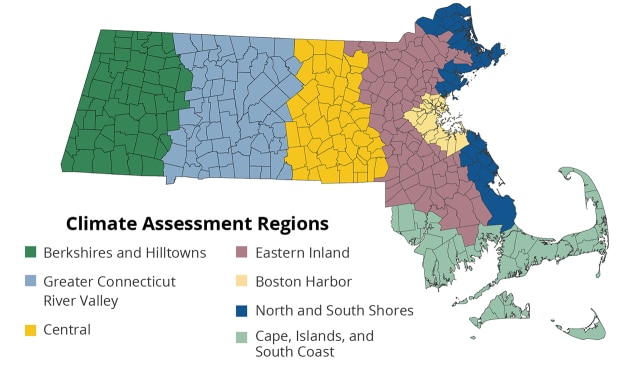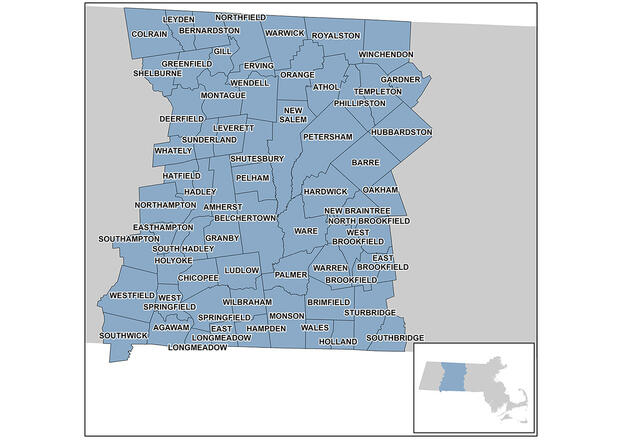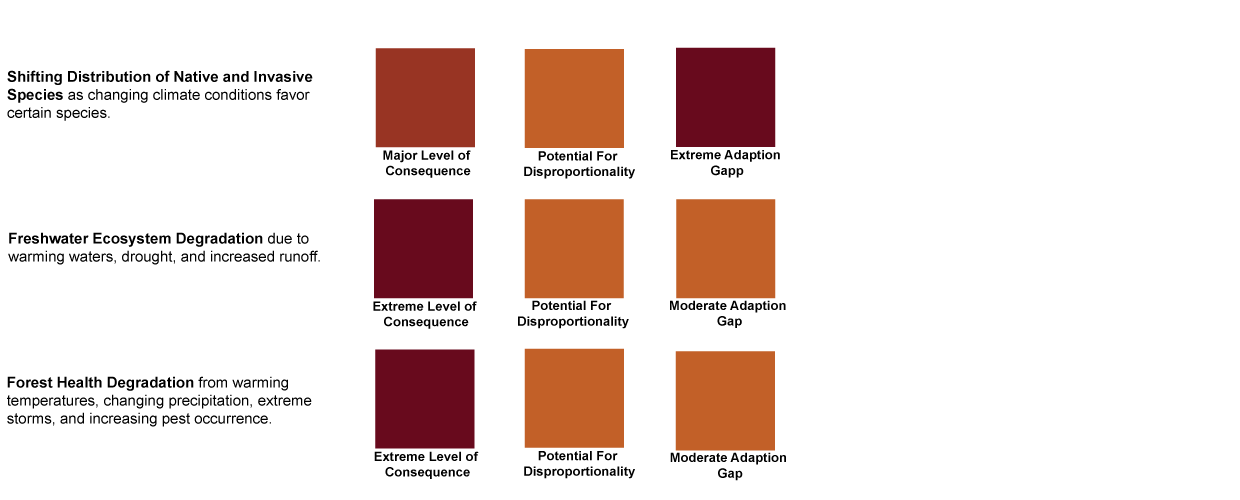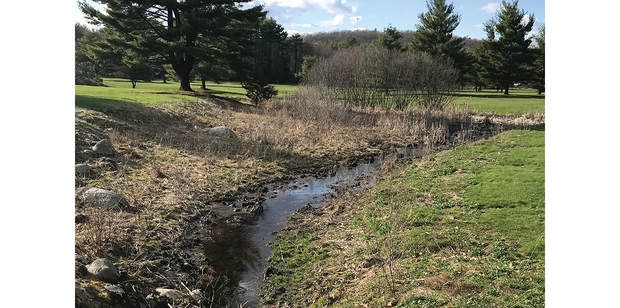Overview
The Commonwealth is already experiencing climate change impacts. Region-specific priorities reflect the unique hazards, natural and built environments, and demographics of each part of the Commonwealth. The Climate Assessment evaluated risks across seven regions:
- Berkshires and Hilltowns Region
- Greater Connecticut River Valley Region
- Central Region
- Eastern Inland Region
- Boston Harbor Region
- North and South Shores Region
- Cape, Islands, and South Coast Region
Volume III of the Climate Assessment includes a summary and full report on each region.
Share These Findings
Share findings about the Greater Connecticut River Valley region from the MA Climate Change Assessment with your community through the example social media content below:
Regional Context
The Greater Connecticut River Valley region is primarily rural, though it does feature the state’s third largest city, Springfield, and surrounding cities, as well as networks of larger villages. The region accounts for about 11 percent of the state’s population but includes nearly 21 percent of its low-income block groups. Overall, more than 52 percent of the Greater Connecticut River Valley’s block groups receive EEA’s environmental justice designation, making the region one of only two where more than half the block groups are considered socially vulnerable. The regional economy largely reflects the statewide economy, with healthcare, finance, insurance, and professional services playing large roles. Agriculture is also a major player in the region for employment and economic output.
The boundary used for this assessment matches the Municipal Vulnerability Preparedness (MVP) program’s Greater Connecticut River Valley region. Climate adaptation work is progressing in the region, but a few communities still have yet to engage in climate resilience planning through the MVP program.
The most important climate hazards for the region include temperature extremes, changes in precipitation patterns, and consequent changes in the patterns of river flows, particularly in the Connecticut River and its network of tributaries. Each of these affects both the urban areas in the southern portion of the region and the agriculture and natural resources that characterize the northern, more rural areas.
Most Urgent Impacts - Human Sector
Reduction in Food Safety and Security and Health Effects of Extreme Storms and Power Outages are the most urgent impacts in the Greater Connecticut River Valley region. Here, local agricultural supplies and economies are more heavily dependent on local food production. The region accounts for 57 percent of statewide agricultural productivity and could see key commodity crop yields decline by eight percent by 2030 and 20 percent by 2070. Food safety concerns like spoilage and bacterial contamination are also associated with high temperature events and risk of power outages. One of the largest food distribution centers in Massachusetts is located in Springfield and supplies consumers throughout the Commonwealth. It is located within the 100-year floodplain of the Connecticut River, where it may be vulnerable to flooding, potentially leading to interruption of food supply chains. Flood risks also directly threaten human health through increased risk of injury and disease both during and after the event. These impacts are also disproportionately distributed in the region.
Most Urgent Impacts - Infrastructure Sector
The region’s top Infrastructure sector vulnerabilities align with key statewide impacts. The Greater Connecticut River Valley region has a high risk for inland flooding when measured as a percentage of the total structure value in the region, although this risk is widely differentiated across the region. The region is also expected to have the largest absolute annual economic impact of inland flooding in the Commonwealth by 2030, with $12 million in added annual costs. These economic damages attributed to climate change could double by 2090 to $24 million despite the finding that some more sparsely populated portions of the eastern portion of the region could see a decline in flood risk. These risks are particularly disproportionate in the region. Springfield and other neighboring communities (e.g., Holyoke, Chicopee) have invested in flood control, but adaptation efforts, particularly those aimed at residential properties, are currently limited across much of the region.
A range of climate stressors including extreme temperature, extreme storms, lightning, vegetation growth, wildfire activity, and coastal flooding threaten transmission and distribution lines, poles/towers, and transformers, making Damage to Electric Transmission and Distribution Infrastructure another key impact in the region. Added annual repair costs are projected to exceed $6 million by 2030 and reach nearly $23 million by 2090.
Read more about infrastructure sector impacts in the report.
Most Urgent Impacts - Natural Environment Sector
The region’s natural resources are expected to face significant pressure from climate change. The most urgent Natural Environment sector risks in the Great Connecticut River Valley are Shifting Distribution of Native and Invasive Species, Freshwater Ecosystem Degradation, and Forest Health Degradation. The three are closely related—climate change will alter existing biogeochemical cycles that support viable forest and freshwater habitats for native species to thrive and may consequently make it viable for invasive flora and fauna to thrive. Changes to temperature and precipitation regimes will shift growing seasons and impact nutrient availability, forcing forest ecosystems to transition and potentially diminishing the ecosystem services they provide. Changing flow patterns of waterways due to seasonal shifts, increased nutrient loading and harmful algal bloom growth, and increased contaminant concentrations during drought conditions threaten freshwater ecosystems. All of these ecosystem impacts could shift the competitive balance of native and invasive species, and extreme weather events could make ecosystems more vulnerable to pests and disease, weakening the ability of native flora and fauna to adapt to a new climate.
*Due to tied scores in the urgency rankings, the Natural Environment sector has three most urgent impacts for this region.
Read more about natural environment sector impacts in the report.
Most Urgent Impacts - Governance Sector
The Greater Connecticut River Valley’s key Governance sector impacts are aligned with the most urgent statewide impacts: Increase in Costs of Responding to Climate Migration and Reduction in State and Municipal Revenues. Climate migration remains an emerging risk for Massachusetts, but there is direct experience with this impact in the region. Most notably, in 2017 and 2018, Holyoke—the Massachusetts city with the highest concentration of people of Puerto Rican descent in the contiguous U.S.—welcomed 142 Puerto Rican households permanently displaced and hundreds more temporarily displaced by Hurricane Maria.
Most Urgent Impacts - Economy Sector
Decrease in Agricultural Productivity and Reduction in the Availability of Affordably Priced Housing are the most urgent impacts in the Economy sector for the region. The Greater Connecticut River Valley is home to the most farmland out of any region in the Commonwealth at 130,000 acres. Farming and agricultural revenues are important parts of the economy and identity of the region. Temperature and precipitation pattern changes may make it difficult to continue the cultivation of crops historically grown in the area while creating the opportunity to transition toward new crops. Pressures such as loss of pollinators, extreme storms, and invasive species and pests introduce further uncertainty into the agriculture industry, which is already facing economic pressures.
An increase in demand for housing and a decrease in supply are expected to negatively impact housing affordability. Relocation due to direct damage to existing housing or climate-related economic pressures drives increasing demand. Direct physical damage from climate impacts and higher construction costs needed to increase climate resilience may limit the availability of affordably priced housing. This region has a high potential inland flood risk to housing Both demand and supply effects raise rental and ownership prices, which can effectively limit options for affordably priced housing, particularly for low-income populations.
Featured Adaptation Effort
Pine Grove Golf Course Site Restoration: The City of Northampton, in partnership with MassAudubon, restored 105 acres of land formerly used as a golf course. The project included permanent protection of the land, removal of drainage infrastructure, and elimination of multiple stream crossings. Ten acres of previously drained wetlands were restored, and greenways were reverted to early successional forests.
Quick links
- ResilientMass Homepage
- ResilientMass Site Map
- Massachusetts Climate Change Assessment
- Massachusetts Climate Change Assessment – Berkshires and Hilltowns Region
- Massachusetts Climate Change Assessment – Central Region
- Massachusetts Climate Change Assessment – Eastern Inland Region
- Massachusetts Climate Change Assessment – Boston Harbor Region
- Massachusetts Climate Change Assessment – North and South Shores Region
- Massachusetts Climate Change Assessment – Cape, Islands, and South Coast Region
- Massachusetts Climate Change Assessment – Regional Summary Volume III
- Massachusetts Climate Change Assessment – Regional Report Volume III










